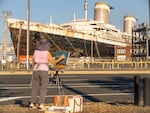
The SS United States' departure from Philadelphia has been delayed by the weather. A team from NPR climbed aboard before it takes its final voyage.
Stephen Mallon for NPR
In the coming days, the United States is expected to take its final voyage, on its way to be buried at sea.
It’s not the country nearing its end, but a ship that bears its name. The SS United States is a mid-20th century ocean liner that set the speed record for crossing the Atlantic. Now tied up at a Philadelphia pier, its paint peeling and faded after decades of inactivity, it’s bound for an ending that is, in reality, a new phase of its life: serving as an artificial reef that attracts divers and marine life in the waters off Florida.
It’s an intricate job to tow a 990-foot ship that no longer has its own working engines. The ship’s planned departure from Philadelphia last week was delayed by the weather, and a new date hasn’t been set. But the United States must go. The pier operator wants its dock space back, and its sale has been completed.
Before departure, a team from NPR climbed aboard what is, in effect, a ghost ship — a relic from the era of great liners that connected North America with Europe. Some of the most famous of these ships are those that sank, like the Andrea Doria, the Lusitania and the Titanic. The builders of the United States learned from others' mistakes, and it will not go down until it’s scuttled by design.

The foredeck of the SS United States, completed in 1951.
Stephen Mallon for NPR
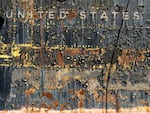
The ship's hull, designed to withstand extreme stress, remains watertight despite decades without maintenance.
Stephen Mallon for NPR

The United States' mid-20th century modern interiors were long ago stripped to dispose of asbestos, though the spaces still suggest their past grandeur.
Stephen Mallon for NPR
“If this ship had hit the Titanic’s iceberg, there is no way she would have sunk,” said Susan Gibbs, whose grandfather designed the United States and who has struggled for two decades to preserve it. She told the history of the ship while standing on the foredeck on a sunny afternoon.
“It was a top secret Cold War weapon,” she said. “Its keel was laid right as the Soviet Union tested the atomic bomb.”
The U.S. Navy paid most of the bills because the passenger ship had a military purpose. It could easily be converted to carry thousands of U.S. troops to a war zone, which was a function served by the British liners Queen Mary and Queen Elizabeth during World War II.
Gibbs' grandfather, William Francis Gibbs, was a Philadelphia native who was fascinated by ships as a child and grew up to design them even though he had no formal training. His achievement during World War II was building so-called Liberty Ships, cargo vessels that carried food and weapons to Europe; they had to be designed and built in such a way that they could be completed by the thousands, more rapidly than German submarines could sink them.
After the war, Gibbs persuaded the government to help him complete his dream: the fastest and safest liner afloat. Its advanced engines and propellers allowed it to sail at 44 land miles per hour — so fast that many warships and submarines of the era would have trouble catching it. (The Queen Mary’s top speed was around 37, and most ships were far slower.)
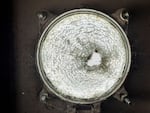
One of the portholes on the United States.
Stephen Mallon for NPR
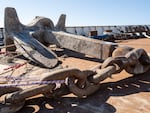
The ship's design blended traditional elements like this anchor with high-speed engines, durability and immense size; it is 990 feet long.
Stephen Mallon for NPR

Susan Gibbs' grandfather, William Francis Gibbs, was a Philadelphia native who was fascinated by ships as a child and grew up to design them even though he had no formal training. His achievement during World War II was building so-called Liberty Ships, cargo vessels that carried food and weapons to Europe; they had to be designed and built in such a way that they could be completed by the thousands, more rapidly than German submarines could sink them. She talked about the history with NPR.
Stephen Mallon
Watertight compartments made the ship extremely hard to sink; and Gibbs obsessively removed the flammable wood that ordinarily would have formed much of the ship’s interior decor. He insisted on lightweight aluminum — even trying to persuade the piano maker Theodore Steinway to produce an aluminum grand piano.
“Steinway thought that might affect the tonal quality of the instrument, so he refused,” Gibbs said. He finally persuaded the shipbuilder to accept a mahogany piano by dousing the instrument with gasoline and setting it alight; the fuel burned off the hardwood without affecting it.
The ship never served in wartime, instead spending the years from 1952 to 1969 in passenger service for the United States Lines. Musicians including Duke Ellington performed at the mahogany piano in the ballroom. Several presidents were among the passengers; Margaret Truman, a president’s daughter, came along for the record-breaking maiden voyage.
The ship was retired in 1969 as jet travel took over. In more recent years, Susan Gibbs tried to have it repurposed as a floating hotel, which never quite worked.
At last, Okaloosa County, Fla., proposed converting it into the world’s largest artificial reef.
“I’ve shed a few tears.” Susan Gibbs told me. But she added, “this is her next chapter and I am coming to terms with it. And I think it will offer its own sense of dignity and make me even more determined to continue to tell her story.”
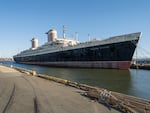
The pressure to vacate this pier finally forced a sale that will see the United States sunk as an artificial reef off the Florida coast.
Stephen Mallon for NPR
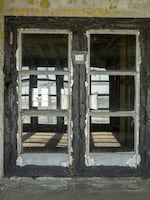
Only a few bits of the United States' mid-20th-century modern decor remain.
Stephen Mallon for NPR
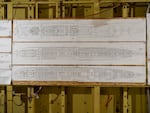
Diagrams of the ship's decks highlight some of its luxury features, including a first-run movie theater, visible on the top chart, center left.
Stephen Mallon for NPR
I noted that she referred to the ship as “her,” which is the traditional way that ships are discussed. Did the United States have a personality in her mind?
“Yes,” Gibbs said. “I see this ship as a feminist icon. She’s tough. She’s tough and strong and resilient and holds so much.”
Before the sinking, its faded red, white and blue funnels are to be removed and brought to land. They are to be centerpieces of a marine museum, relics of an earlier phase of global travel.
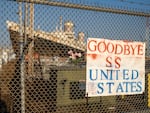
Stephen Mallon for NPR
The audio version of this piece was edited by HJ Mai and produced by Kaity Kline and Julie Depenbrock. The digital version was adapted by Majd Al-Waheidi.